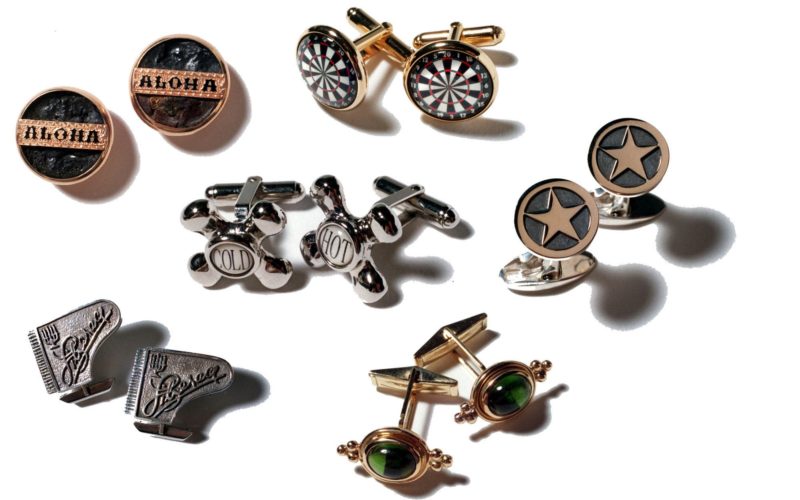Q. My wife says I need a shirt with French cuffs when attending a formal or dressy occasion. In fact, she thinks I should own a few. I’ve never paid much attention to fashion, but I really don’t like them. Can’t I just wear a fine white shirt with regular cuffs?
A. No, you cannot. If the occasion is truly formal (black tie), then a French-cuff shirt and cuff links are required. Formalwear has its own set of strict rules that are not to be ignored. If, on the other hand, it is a dressy occasion, but not actually formal, then, yes, of course, you can just choose a fine shirt with regular button cuffs. But what is your objection to such a sensible suggestion?
You don’t need to be a fashion guy to enjoy some of the pluses of French cuff shirts. Mainly, they have the advantage of nicely dressing up your overall look without needing a lot of sophisticated knowledge, without great expense, and without adding any extra accessories (such as a dress watch, a tie clasp, or a pocket handkerchief). Of course, they do require cufflinks, but you can get away with owning only one pair of those as well.
A French cuff is a double length shirt cuff that is stitched on separately and then turned back on itself and fastened with a cufflink. The style actually originated in Great Britain. It wasn’t originally called the French cuff, but was known as the foldback, or turnback, or double cuff, with six holes for cufflinks, rather than the four that we have today. It was very practical: when the shirt was worn on more than one day, the dirty part of the cuff could be turned under a bit and not seen. This dressy shirt style became known as the French cuff when it reached America.
In the 1930’s, cufflinks were popular as a status symbol. Cufflinks became an extremely popular accessory in keeping with various dressy eras; think Mad Men of the 1960’s, Saturday Night Fever of the 70’s, and Wall Street of the 80’s.
Here are a few points about French-cuff shirts:
- They are always dressier than barrel-cuff (button-cuff) shirts.
- They usually come in finer, more luxurious fabrics than button-cuff shirts.
- They come in a range of collar styles, including straight point, slight spread, and wide-spread.
- They are a step too dressy for (and should not come with) a casual button-down collar.
- Beyond black-tie attire, they are best worn with a dressy suit or a fine blazer, and are less appropriate with a casual tweed sports coat.
- They might be too dressy for some industries and for many business-casual workplaces.
Now, why wear them? Because they are as key to formal wear as the bow tie, and in other settings they make a man stand out as well dressed!
Some years ago I was in Treviso, a small city north of Venice, on a business trip with my husband. We were taken on a plant visit and out to lunch by the head of the company.
Apparently, we impressed Giorgio, our host, because we were then invited to his home for the following evening’s dinner. He assured us that it would be quite “simple.” I assured my husband, however, that nothing about the dinner would be simple. How did I know? he asked. I said, “Anyone who shows up in a sporty little Fiat, as Giorgio did, dressed in such a studiedly casual way with smart leather driving gloves and fine shoes to show us around a stone quarry, would not do anything in a simple way. Least of all, would he give a ‘simple’ dinner party.”
I also believed that I had discovered a style peculiar to the region. The style was that of wearing French cuffs open: that is to say, unfastened, without cuff links. My husband, a pretty sharp dresser himself, said that perhaps Giorgio had forgotten to put them on. I said, “That man? He would never forget anything. I’m sure it’s a style.”
The next evening we arrived at a jewel of an Italian villa decorated with elegant (well, at the time) brown velvet furniture. Our host’s wife had been a model in Milan; she swept into the room in that distinctive way of walking that models have, looking gorgeous.
Giorgio and two other male guests all wore French-cuffed shirts, devoid of cuff links. My guess was right.
Later I learned the reason for their “lapse.” Italian men in that upper social stratum all dressed so absolutely perfectly that, in order not to appear as dandies, they purposely created a mistake in their appearance. In the same way, weavers of the world’s finest Oriental silk rugs, purposely cast a mistake into the design. Nothing should be too perfect. In the years since that dinner, I have learned that the world has a name for this concept. It is sprezzatura (sprez-za-tu’-ra). An Italian word that first appeared in 1528, it is an on-purpose habit of creating some small error in order to seem nonchalant and not overly concerned with appearances.
Today in Italy, and especially in America, French-cuff shirts are worn with the cufflinks (at least at the start of the evening). To return to your wife’s recommendation, I can report that women love to give men handsome cuff links as a gift for a lot of reasons . . . one of which is they don’t need to know his exact size.
Please send your men’s dress and grooming questions to MALE CALL: Lois.Fenton@prodigy.net









